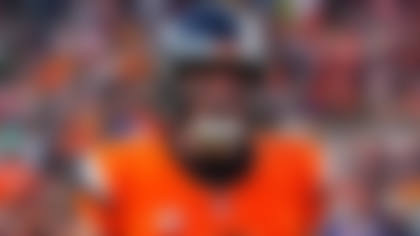May and June are the months to ask your football questions, and I will try and get them answered. There was a great response to the opportunity from NFL fans from places outside of the USA in the first week of inquiries. Here are five NFL fans -- two from England, two from Norway and one from Canada. Keep the questions coming. If it's on your mind, it's on someone else's mind as well.
Question: What is a dime and or nickel package? -- Anders Hassel, Trondheim, Norway
Anders, a nickel package is when a defense substitutes into a game an extra defensive back usually for a linebacker. On some occasions, a linebacker will move up to a pass rush position and a defensive lineman will leave the game. Nickel defenses are usually substituted into games when the opponent goes to a three-wide receiver package or when the down and distance situation dictates more pass than run, i.e. third down and 10 yards.
A dime defense is when two defensive backs come into a game for either two linebackers, or a combination of a linebacker and a defensive lineman. Dime defenses are most often used when the opposing offense decides to use four wide receivers and one running back, or recently a few teams have gone to five wide receivers and no running back.
Question: When is it offensive pass interference? When is it defensive pass interference? When can a defender touch the receiver? -- Kjartan Breivik, Norway
Kjartan, pass interference is one of the biggest rule situations in football. As it relates to when a defender can touch a receiver, it has to do with the first five yards from the line of scrimmage. An eligible receiver is considered to be an obstructing opponent only to a point five yards beyond the line of scrimmage unless the player who receives the snap (usually the quarterback) clearly demonstrates no intention to pass the ball. The defender can maintain continuous and unbroken contact within the five yards until the receiver is even with him. Defenders can't push a receiver from behind. Keep in mind if a ball is thrown at the receiver in the first five yards of the line of scrimmage the defender can't be in contact with the receiver.
As for offensive interference the restriction for the passing team starts with the snap of the ball. The penalty for offensive pass interference is 10 yards from the previous spot. It is always pass interference either offensive or defensive if the player movement beyond the line of scrimmage significantly hinders the progress of the other player to catch the ball. Offensive pass interference usually is called when the receiver pushes off the defender to create separation.
Defensive pass interference causes an automatic first down at the spot of the foul. If it happens in the end zone the ball is spotted at the one yard line. The defender has to be playing the ball and can't restrict the receiver's movement to make a catch. The defender can't 'bar' a receiver by extending an arm and preventing the receiver from passing him.
Question: In a punt or field goal situation, if a player with speed lines up behind the kicker/punter and after the ball is kicked chases down field can he recover and advance the ball? -- Sam McGaffin, Loughborough, England
Sam, I played rugby Union for 10 years and I can see that you are really wondering if rugby rules apply. They do not apply to American football and let me explain. On a punt it is not a live ball as it would be in rugby. In rugby the ball is the line of scrimmage and as you know when a team uses a pop kick, the idea is to run under the ball and get it back. In American football, the team receiving the ball has the right to catch it and if they elect not to try and catch it they receive the ball where it stops. Only if the receiving team mishandles the ball does it become a live ball.
As for the field goal attempt, there is no opportunity to gain the ball back for the same reasons. The one play in football that has the same logic as rugby is the kickoff. Once a kickoff goes 10 yards it is a free ball just like rugby. I always thought that a good kickoff man who could pop a kickoff rugby style in American football could set up the kicking team very well to regain the ball.
Question: What are the different skill sets for guards versus tackles? What is the difference between a right tackle and a left tackle? Can a team use more than five linemen if they want to? And how does the Denver zone running scheme work? -- Ben Clapperton, England
Ben, guards play inside between the center and the tackle. Traditionally, they are shorter and more powerful than the tackles. In a rugby analogy they are the props while the tackles are the second row. Guards usually work in a much shorter space and are rarely asked to block a wide pass rusher. The tackles have to be able to block a wide pass rusher and need to be nimble on their feet especially the left tackle.
A left tackle protects the blind side for the right-handed quarterback. He needs to be able to stop a speed rusher from the outside and will need to double kick to gain width. At the same time he has to be concerned about the pass rusher who brings a power move to his chest. A right tackle traditionally is more of a power run blocker and he usually lines up with a tight end next to him to help occasionally. Most right tackles are bigger and more powerful than this counterpart on the left side.
A team can bring in a sixth lineman but he must declare as an eligible receiver. The Packers used a six offensive linemen package a few years ago to get more running lanes for the offense. The downside to this maneuver is one less pass receiving threat on the field.
Denver's zone scheme is all about all five linemen moving in a synchronized fashion letting the defense expose where they intend to go and then having the right blocker take the defender. Usually the zone running teams look for quicker, smaller linemen. Once again, think of a small pack in rugby who wins the ball more by wheeling the scrum than having a great push like a big scrum.
Question: How would an uncapped year limit free agency? Also, if the draft were to go away after 2011, what would take its place? -- Gerry Desormeau, North Bay, Ontario
Gerry, an uncapped year in 2010 would mean three things to potential free agents. To become free a player will need six years of service in the league and have an expiring contract. In a capped year he only needs four years of service. Estimates are that upward of 170 players could be affected by this rule in 2010. Secondly, teams would have the use of three "tags" to control the freedom of potential free agents. In a capped year they only have one tag. This could easily restrict another 30 players. And finally the final eight teams in the playoffs in 2009 would be restricted from signing free agents unless they lost free agents.
If the draft went away, and I doubt it will come to that, then it is a free enterprise system where teams try and sign the players they want with no restrictions. That would upset the balance of talent the league enjoys now, but it might also mean draft-eligible players would not receive the money they enjoy in this system.
Have a football-related question for Pat that you would like answered in a future column? Email him at footballmentor@aol.com. "Movin' the Chains," Pat's SIRIUS NFL Radio show with co-host Tim Ryan, can be heard weekdays from 3-7 p.m. ET.



